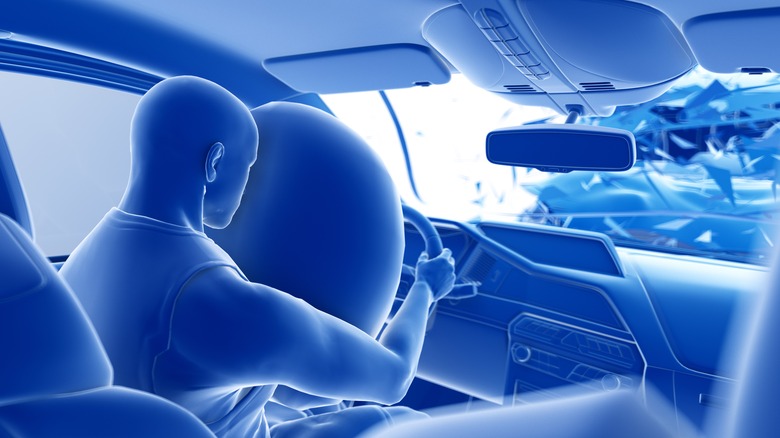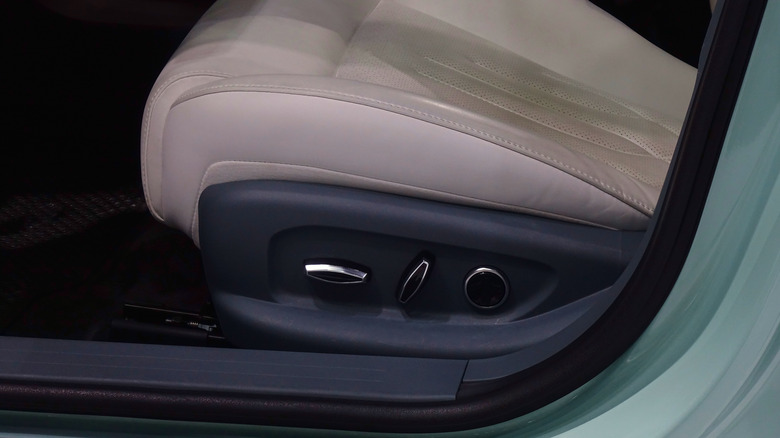How Far Away Should You Be From The Steering Wheel? This Is The Safest Distance
Compared to just a few decades ago, cars are safer than they've ever been. A plethora of built-in safety systems constantly monitor for danger both inside and outside the vehicle. The car uses alerts to keep you attentive at the wheel, watching for changes in terrain or erratic motorists, and controlling motor functionality to prevent collisions, fires, and more.
All of this has made cars generally safer to drive, if not more expensive. However, no matter how high-tech cars become, there's no substitute for old fashioned sense and sensibility. Your car may have all the latest bells and whistles to keep you safe in extenuating circumstances, but that all comes with the assumption that you're doing your part to ensure a safe driving experience in all other circumstances.
For instance, have you thought lately about how closely you sit to your car's steering wheel? It might not be something you think about very often. For many drivers, the only thought spared to the wheel is "ten o' clock and two o' clock," if that. In actuality, placing yourself at an ideal distance and positioning from the wheel is actually one of the most important safety measures you can take in a car.
Your distance from the steering wheels determines where you'll end up in the event of a sudden collision, not to mention what condition you end up in. According to the National Highway Traffic Safety Administration's guidance, you should maintain a distance of about 10 inches from the wheel at all times, and there's a good reason for that.
You should sit about 10 inches away from the steering wheel
The National Highway Traffic Safety Administration advises that all drivers should maintain a distance of about 10 inches from the steering wheel while driving. There are a couple of reasons for this, but they all revolve around a single, vital factor: the airbag.
If you've never had a car's airbag deployed in your face, count yourself lucky, because it's an extremely unpleasant experience — to put it mildly. An airbag is meant to safely receive you in the event of a sudden, forceful collision, preventing your head and upper body from hitting any of the car's solid surfaces, especially the windshield. However, an airbag is designed with the assumption that you're both wearing your seatbelt, and are seated a reasonable distance from the steering wheel it deploys from.
When an airbag deploys from the steering wheel cover, it can do so at speeds of up to 200 miles per hour, and with around 2,000 pounds of force. If you're seated 10 inches away and lurch forward, you should safely bump into the airbag after it's already fully deployed and stopped. If you're hunched over with your head directly in front of the steering wheel, then that bag is going to deploy right into your face. That's going to result in a broken nose at the bare minimum, and possibly an even more severe injury than that.
Position yourself in a way to optimize safety and minimize risk
In addition to safe seating distance, experts recommend configuring your seat in a few particular ways to ensure a safe, soft bumping with the airbag in the event of a collision. Maintaining that 10-inch distance is definitely the most important part, but there are a few positioning tweaks you can use to lessen that risk a little bit more.
For one thing, you should move your seat back a good distance, as well as keep the rear slightly reclined. A little extra clearance will give the airbag a little extra time to fully and safely deploy before you make contact with it. If you're of shorter stature and can't reach the gas and brake pedals unless your seat is closer, consider investing in a pair of pedal extenders. These will allow you to comfortably press the pedals while still keeping your seat a safe distance away.
Additionally, if your steering wheel has an adjustment mechanism, try to angle it slightly downward, more toward the core of your body than the top. If the airbag deploys right into your head, even at a safe distance, you could suffer an injury to your face or neck. Try to angle the wheel so the airbag would deploy right into your center of mass, so you can safely absorb the blow with your whole body.


